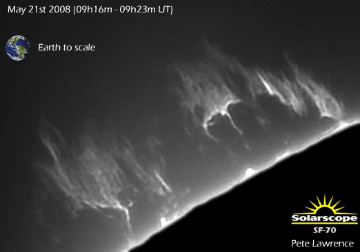 
AND GOD SAID,BE COOL MAN!
| Brampton, Ontario |
Latitude: 43.7 |
Longitude: -79.8 |  Diving into the Earth far in the distance is part of our Milky Way Galaxy. Much closer, the planet Jupiter is visible to band's left. Closer still are buttes and mesas in Utah. In the foreground is a cave housing a stone circle of unknown origin named False Kiva Diving into the Earth far in the distance is part of our Milky Way Galaxy. Much closer, the planet Jupiter is visible to band's left. Closer still are buttes and mesas in Utah. In the foreground is a cave housing a stone circle of unknown origin named False Kiva
In the evening of June 17, 2 BC, there was a spectacular astronomical
event in the western sky. Venus moved eastward seemingly going to collide with Jupiter.  They appeared as one star, not two, dominating the twilight of the western sky in the direction of Palestine.
This conjunction had not happened for centuries. Jupiter was considered the Father, Venus the Mother. Then 19 days later,
on August 31st Venus came within . 36 degrees of Mercury. On Sept 11 came the New Moon, the Jewish New Year. This happened
when Jupiter, the King planet was approaching Regulus, the King star. Further, there were three conjunctions of Jupiter and
Regulus within the constellation of Leo, the lion which was considered the head of the Zodiac. Now Gen 49:10 had foretold
there would always be a ruler from Judah, whom Jacob called the lion, until the time of the Messiah. Leo was dominated by
the star Regulus, which astronomers called the King Star. The Magi, being astronomers and astrologers, would surely read these
signs. (The three conjunctions with Regulus were Aug 12, 3 BC; Feb. 17, 2 BC, and May 8/9 2BC). Also, on Dec. 25 of 2 BC,
Jupiter stopped for 6 days over Bethlehem. This is a normal motion for Jupiter, it stops twice, and reverses its seeming movement.
This may have been the very time the Magi came with their gifts. Martin thinks the birth of Jesus was in September
3 BC, and the probable date of the Magi was Dec. 25, 2 BC. They appeared as one star, not two, dominating the twilight of the western sky in the direction of Palestine.
This conjunction had not happened for centuries. Jupiter was considered the Father, Venus the Mother. Then 19 days later,
on August 31st Venus came within . 36 degrees of Mercury. On Sept 11 came the New Moon, the Jewish New Year. This happened
when Jupiter, the King planet was approaching Regulus, the King star. Further, there were three conjunctions of Jupiter and
Regulus within the constellation of Leo, the lion which was considered the head of the Zodiac. Now Gen 49:10 had foretold
there would always be a ruler from Judah, whom Jacob called the lion, until the time of the Messiah. Leo was dominated by
the star Regulus, which astronomers called the King Star. The Magi, being astronomers and astrologers, would surely read these
signs. (The three conjunctions with Regulus were Aug 12, 3 BC; Feb. 17, 2 BC, and May 8/9 2BC). Also, on Dec. 25 of 2 BC,
Jupiter stopped for 6 days over Bethlehem. This is a normal motion for Jupiter, it stops twice, and reverses its seeming movement.
This may have been the very time the Magi came with their gifts. Martin thinks the birth of Jesus was in September
3 BC, and the probable date of the Magi was Dec. 25, 2 BC.
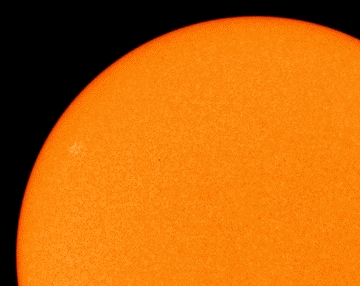 The sunspot's two dark cores are each about the size of Earth, and they are crackling with B-class solar flares. During years of Solar Max (e.g., 2000-2002) we would consider such activity minor, but now, during
the deep solar minimum of 2008-2009, it merits attention. The magnetic polarity and high latitude of the sunspot identify
it as a member of new Solar Cycle 24, expected to peak in 2013. This makes sunspot 1019 a sign of things to come. Readers
with solar telescopes should take a look. The sunspot's two dark cores are each about the size of Earth, and they are crackling with B-class solar flares. During years of Solar Max (e.g., 2000-2002) we would consider such activity minor, but now, during
the deep solar minimum of 2008-2009, it merits attention. The magnetic polarity and high latitude of the sunspot identify
it as a member of new Solar Cycle 24, expected to peak in 2013. This makes sunspot 1019 a sign of things to come. Readers
with solar telescopes should take a look.
The Pleiad(e)s were the seven daughters of Atlas and Pleione, and half-sisters of the Hyades, whose mother was Ęthra
(`bright sky'; a different Ęthra than the mother of Theseus).  F. E. Fillebrown engraving of The Dance of the Pleiades by Elihu Vedder F. E. Fillebrown engraving of The Dance of the Pleiades by Elihu VedderThey were perhaps
also half-sisters of the Hesperides, who were daughters of either Night alone, or Atlas and Hesperis (`evening'), or Ceto
and Phorcys. Both Pleione and Ęthra were Oceanids, daughters of Oceanus and Tethys, the titans who ruled the outer seas before
being replaced by Poseidon. Atlas (`he who dares' or `suffers'; from the Indo-European tel-, tla-, `to lift,
support, bear'), another titan, led their war against the gods, and was afterward condemned by Zeus to hold up the heavens
on his shoulders.  A color-composite image of the Pleiades from the Digitized Sky Survey. A color-composite image of the Pleiades from the Digitized Sky Survey.
The Pleiades were also nymphs in the train of Artemis, and together with the seven
Hyades (`rainmakers' or `piglets'; individual Hyad names are not fully agreed upon) were called the Atlantides, Dodonides,
or Nysiades, nursemaids and teachers to the infant Bacchus. The Hesperides (`nymphs of the west'), apparently not counted
in this, were only three, and dwelled in an orchard of Hera's, from which Heracles fetched golden apples in his eleventh labor
 Stars Over Easter Island
Stars Over Easter Island
Seen here between a rendition of the Earth, left, and of a super-Earth
at the same scale, right, Dimitar Sasselov opened the conference. 
COLORADO FIREBALL: Last night, a fireball one hundred times brighter than the full Moon lit up the sky near Colorado
Springs, Colorado. 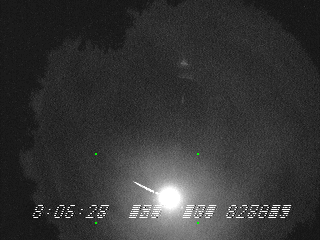 Astronomer Chris Peterson photographed the event using an all-sky video camera dedicated to meteor studies. "In seven years
of operation, this is the brightest fireball I've ever recorded. I estimate the terminal explosion at magnitude -18." Meteors
this bright are called superbolides; they are caused by small (meter-class) asteroids and are likely to pepper the ground
with meteorites when they explode 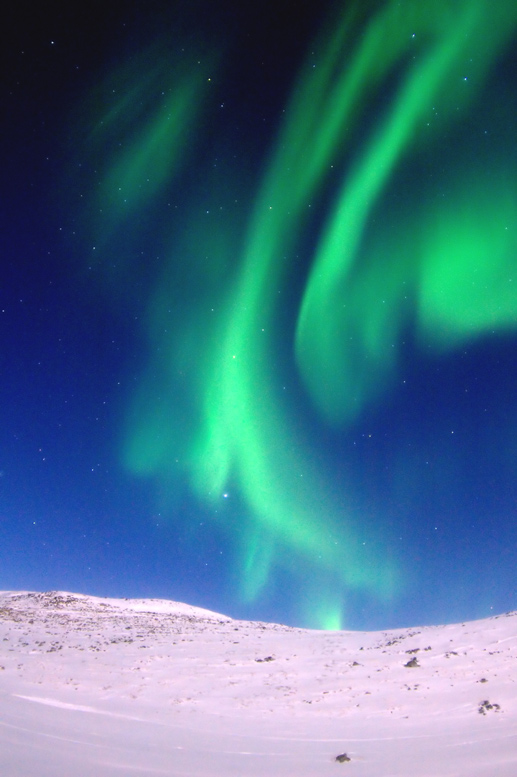
 Plato (left) and Aristotle (right), Plato (left) and Aristotle (right),

Wheel of the zodiac: This 6th century mosaic pavement in a synagogue incorporates Greek-Byzantine
elements, Beit Alpha, Israel 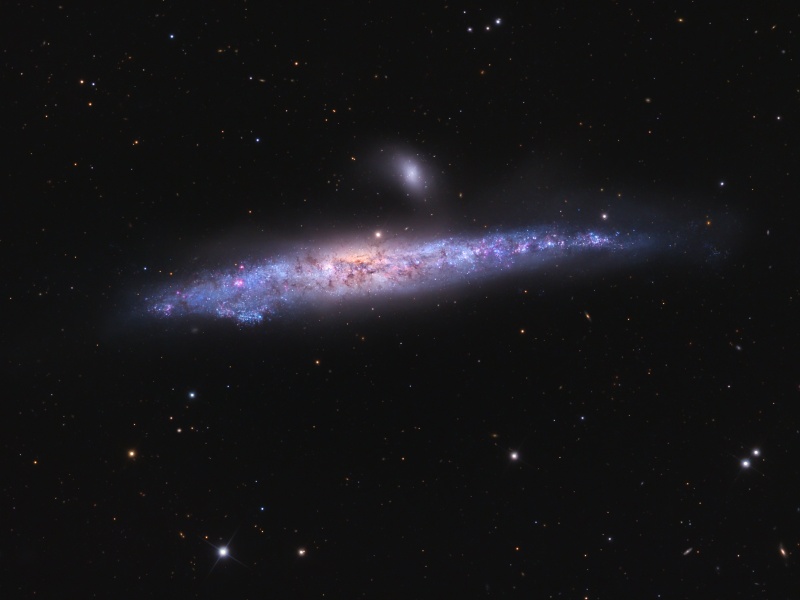 The Whale Galaxy NGC 4631 is a big beautiful spiral galaxy. Seen edge-on, it lies only 25 million light-years away in the well-trained northern constellation Canes Venatici. The galaxy's slightly distorted wedge shape suggests to some a cosmic herring and to others its popular moniker, The Whale
Galaxy. Either way, it is similar in size to our own Milky Way. In this gorgeous color image, the galaxy's yellowish core, dark dust clouds, bright blue star clusters, and red star forming regions are easy to spot. A companion galaxy, the small elliptical NGC 4627, is just above the Whale Galaxy. Out of view, off the lower edge of the picture lies another distorted galaxy, hockey stick-shaped NGC 4656. The distortions and mingling
trails of gas and dust detected at other wavelengths suggest that all three galaxies have had close encounters with each other in
their past. The Whale Galaxy is also known to have spouted a halo of hot gas glowing in x-rays. The Whale Galaxy NGC 4631 is a big beautiful spiral galaxy. Seen edge-on, it lies only 25 million light-years away in the well-trained northern constellation Canes Venatici. The galaxy's slightly distorted wedge shape suggests to some a cosmic herring and to others its popular moniker, The Whale
Galaxy. Either way, it is similar in size to our own Milky Way. In this gorgeous color image, the galaxy's yellowish core, dark dust clouds, bright blue star clusters, and red star forming regions are easy to spot. A companion galaxy, the small elliptical NGC 4627, is just above the Whale Galaxy. Out of view, off the lower edge of the picture lies another distorted galaxy, hockey stick-shaped NGC 4656. The distortions and mingling
trails of gas and dust detected at other wavelengths suggest that all three galaxies have had close encounters with each other in
their past. The Whale Galaxy is also known to have spouted a halo of hot gas glowing in x-rays.
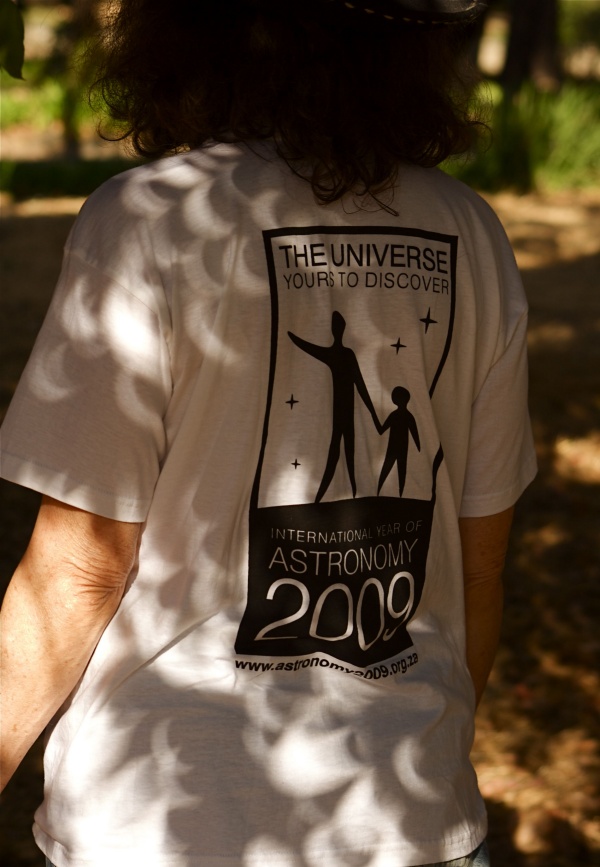 Eclipse Shirt 2009
Eclipse Shirt 2009
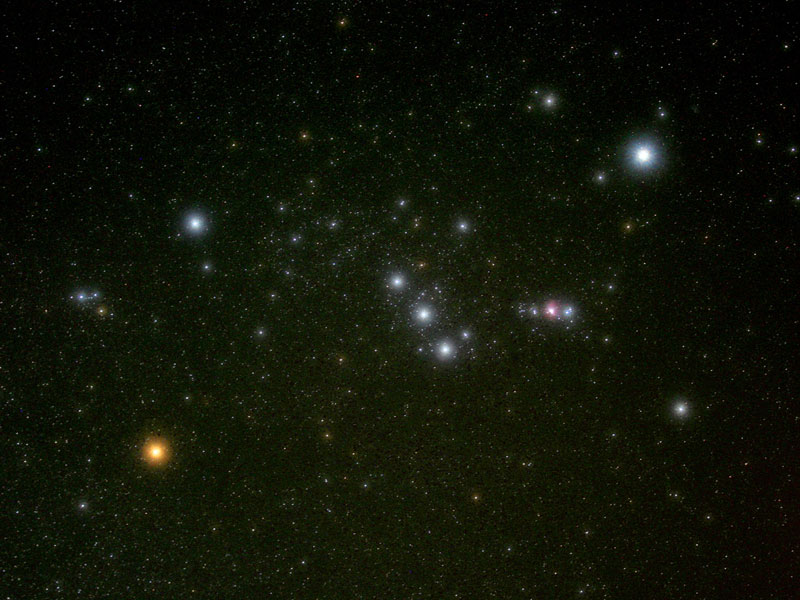 Using Orion to find stars in neighbor constellations 
The " Emu in the sky", a ' constellation' defined by dark clouds rather than the stars. A western interpretation
would recognise the Crux or Southern Cross, on the left Scorpius. The head of the emu is the Coalsack.
![[Stonehenge]](http://physics.nist.gov/GenInt/Time/Images/stone.gif) Celestial bodies — the Sun, Moon, planets, and stars — have provided us a reference for
measuring the passage of time throughout our existence. Ancient civilizations relied upon the apparent motion of these bodies
through the sky to determine seasons, months, and years. Celestial bodies — the Sun, Moon, planets, and stars — have provided us a reference for
measuring the passage of time throughout our existence. Ancient civilizations relied upon the apparent motion of these bodies
through the sky to determine seasons, months, and years.
We know little about the details of timekeeping in prehistoric eras, but wherever we turn up records and artifacts, we
usually discover that in every culture, some people were preoccupied with measuring and recording the passage of time. Ice-age
hunters in Europe over 20,000 years ago scratched lines and gouged holes in sticks and bones, possibly counting the days between
phases of the moon. Five thousand years ago, Sumerians in the Tigris-Euphrates valley in today's Iraq had a calendar that
divided the year into 30 day months, divided the day into 12 periods (each corresponding to 2 of our hours), and
divided these periods into 30 parts (each like 4 of our minutes). We have no written records of Stonehenge, built over
4000 years ago in England, but its alignments show its purposes apparently included the determination of seasonal or
celestial events, such as lunar eclipses, solstices and so on.
![[Viewing the stars to determine a calendar]](http://physics.nist.gov/GenInt/Time/Images/astro2.gif)
The earliest Egyptian calendar [Ref.] was based on the moon's cycles, but later the Egyptians realized that the "Dog Star" in Canis Major, which we call Sirius,
rose next to the sun every 365 days, about when the annual inundation of the Nile began. Based on this knowledge, they
devised a 365 day calendar that seems to have begun around 3100 BCE (Before the Common Era), which thus seems to
be one of the earliest years recorded in history.
Before 2000 BCE, the Babylonians (in today's Iraq) used a year of 12 alternating 29 day and 30 day
lunar months, giving a 354 day year. In contrast, the Mayans of Central America relied not only on the Sun and Moon,
but also the planet Venus, to establish 260 day and 365 day calendars. This culture and its related predecessors
spread across Central America between 2600 BCE and 1500 CE, reaching their apex between 250 and 900 CE. They
left celestial-cycle records indicating their belief that the creation of the world occurred in 3114 BCE. Their calendars
later became portions of the great Aztec calendar stones. Our present civilization has adopted a 365 day solar calendar
with a leap year occurring every fourth year (except century years not evenly divisible by 400). ![[Aztec calendar stone]](http://physics.nist.gov/GenInt/Time/Images/aztec.gif)
Fifty years ago, the legislation creating the National Aeronautics and Space Administration, or NASA, was enacted. There
will likely be a lot of buzz about this anniversary, and rightly so, since it has, among many other things, shaped our understanding
of the Universe so dramatically.
Switching on the world's largest and most powerful particle accelerator near Geneva, Switzerland,
did not trigger the creation of a microscopic black hole. And that black hole did not start rapidly sucking in surrounding
matter faster and faster until it devoured the Earth, as sensationalist news reports had suggested it might.
Of course, because you're alive and reading this article today, you already knew that. Currently
the accelerator, an underground ring 5 miles across called the Large Hadron Collider (LHC), has been shut down for repairs.
But once the immensely powerful machine starts back up, is there a chance that the doomsday scenario could still occur?
Relax. As Mark Twain might have said, reports of Earth's death
have been greatly exaggerated.

Above: An aerial view
of CERN (European Organization for Nuclear Research). The large 5-mile diameter ring traces the underground Large Hadron Collider.
Image credit: CERN
"There never really was a danger from the accelerator, but that
sure didn't stop people from speculating that there might be!" says Robert Johnson, a physicist at the Santa Cruz Institute
for Particle Physics and a member of the science team for NASA's Fermi Gamma-ray Space Telescope, which launched in June to
study gamma rays from many phenomena, including possible evaporating black holes.
There are several reasons why the world did not come to an end
on Sept. 10th, and why the Large Hadron Collider isn't capable of triggering such a calamity.
First of all, yes, it is true that the LHC might create microscopic
black holes. But, for the record, it could not have created one on its first day. That's because the physicists at CERN didn't
steer beams of protons into each other to create high-energy collisions. Sept. 10th was just a warmup run. To date, the collider
still has not produced any collisions, and it is the extreme energy of those collisions — up to 14 tera-electron volts
— that could potentially create a microscopic black hole.
 Right: Any micro black hole created by the LHC would quickly evaporate, losing mass and energy via Hawking radiation.
[more] Right: Any micro black hole created by the LHC would quickly evaporate, losing mass and energy via Hawking radiation.
[more]
Actually, once the LHC is running again and begins producing
collisions, physicists will be ecstatic if it creates a tiny black hole. It would be the first experimental evidence to support
an elegant but unproven and controversial "theory of everything" called string theory.
In string theory, electrons, photons, quarks, and all the other
fundamental particles are different vibrations of infinitesimal strings in 10 dimensions: 9 space dimensions and one time
dimension. (The other 6 space dimensions are hidden by one explanation or another, for example by being "curled up" on an
extremely small scale.) Some physicists tout string theory's mathematical elegance and its ability to integrate gravity with
the other forces of nature. The widely accepted Standard Model of particle physics does not include gravity, which is one
reason why it does not predict that the LHC would create a gravitationally collapsed point — a black hole — while
string theory does.
Many physicists have started to doubt whether string theory is
true. But assuming for a moment that it is, what would happen when a black hole is born inside the LHC? The surprising answer
is "not much." Even if the black hole survives for more than a fraction of a second (which it probably wouldn't), most likely
it would be flung out into space. "It would only have the mass of a hundred or so protons, and it would be moving at near
the speed of light, so it would easily have escape velocity," Johnson explains. Because the tiny black hole would be less
than a thousandth the size of a proton and would have an exceedingly weak gravitational pull, it could easily zip through
solid rock without ever touching — or sucking in — any matter. From the perspective of something this tiny, the
atoms that make up "solid" rock appear to be almost entirely empty space: the vast space between the atoms' nuclei and their
orbiting electrons. So a micro black hole could shoot down through the center of the Earth and out the other side without
causing any damage just as easily as it could shoot up through 300 feet of the Swiss countryside. Either way, it would end
up out in the near-vacuum of space, where the odds of it touching and sucking in any matter so that it could grow into a menace
would be smaller still.
 Right: Inside the Large Hadron Collider. Protons race down this tunnel at 99.999999% the speed of light. [more] Right: Inside the Large Hadron Collider. Protons race down this tunnel at 99.999999% the speed of light. [more]
So the first thing a micro-black hole would do is leave the planet
safely behind. But there are other, even stronger reasons why scientists believe the LHC poses no threat to Earth. For one,
a black hole created in the LHC would almost certainly evaporate before it got very far, most scientists believe. Stephen
Hawking, the physicist who wrote A Brief History of Time, predicted that black holes radiate energy, a phenomenon
known as Hawking radiation. Because of this steady loss of energy, black holes eventually evaporate. The smaller the black
hole, the more intense the Hawking radiation, and the quicker the black hole will vanish. So a black hole a thousand times
smaller than a proton should disappear almost instantly in a quick burst of radiation.
"Hawking's prediction is not based on speculative string theory
but rather on well understood principles of quantum mechanics and particle physics," Johnson notes.
Despite its strong theoretical foundations, Hawking radiation
has never been observed directly. Still, scientists are confident that any black hole created by the LHC would pose no threat.
How can they be so sure? Because of cosmic rays. Thousands of times per day, high-energy cosmic rays strike the Earth's atmosphere,
colliding with molecules in the air with at least 20 times more energy than the most powerful collisions that the LHC can
produce. So if this new accelerator could make Earth-devouring black holes, cosmic rays would have already done so billions
of times during Earth's long history.
And yet, here we are. Let the collisions begin!
I have been afforded the benefit of watching seminars from the PI on Cable 10. I would like to know if I could visit them
in person. I have heard you have aquired the services of one Mr. S. Hawking. Is there ever a chance of a public meet and greet?
His books helped me understand the quantum world. While I understand his disability limits him, I would like just being able
to see him. Mike Milne Centre St. N. Brampton Ont. L6X-2B4
A solar wind stream flowing from the indicated coronal hole will probably pass just above our planet on
February 7th. causing auroras like this one captured in Iceland.
Volcano and Aurora
Leading space scientists gathered in BOULDER, Colorado
to attend a June 9-10 meeting of NASA’s Outer Planets Assessment Group (OPAG), planning, prioritizing, and advocating
a new exploration agenda for the distant planets, there is overwhelming support for dispatching a spacecraft to Jupiter’s
moon, Europa – an ice-covered world that may support an ocean, possibly teeming with life.
| Winter |
Spring |
Summer |
Autumn |
Northern Circumpolar |
Southern Circumpolar | DBONSMITH.COM/BINOC
  The Gemini are distinctly noticeable twin stars to the northeast of Orion The Gemini are distinctly noticeable twin stars to the northeast of Orion
The constellation is 'joined' with Andromeda as the common star Alpheratz serves not only as alpha Andromedae but also
as delta Pegasi.
The Great Square of Pegasus, one of Autumn's notable signs, is first seen in mid-Summer if you face the east around 1 a.m.
It'll be found between Deneb (alpha Cygni) and the horizon, standing on one of its corner (gamma Peg).
 This means that if the observer is facing south and looking high overhead This means that if the observer is facing south and looking high overhead 
| Cygnus is a notable summer constellation featuring numerous binocular binaries,
including two showcase doubles. Several deep sky objects are also of some interest.
Click on any orange-coloured object. |
 

Two very special missions are planned for the near future; both
aim to deploy a solar sail to harness the power of sunlight. NASA's NanoSail-D is a small solar sail slated for launch as
early as August 2008. The Planetary Society's Cosmos 2 does not yet have a specific launch target date. Its goal is to make
"a controlled flight under sunlight pressure."1 Almost 400 years ago, German astronomer Johannes Kepler observed
comet tails being blown by what he thought to be a solar "breeze."2 This observation inspired him to suggest that
"ships and sails proper for heavenly air should be fashioned" to glide through space.
Little did Kepler know, the best way to propel a solar sail is
not by means of solar wind, but rather by the force of sunlight itself. In 1873, James Clerk Maxwell first demonstrated that
sunlight exerts a small amount of pressure as photons bounce off a reflective surface. This kind of pressure is the basis
of all modern solar sail designs. Count Dooku's solar sailer or
photon sails, especially when they use light sources other than the Sun) are a proposed form of spacecraft propulsion using large membrane mirrors. Radiation pressure is about 10-5 Pa at Earth radii[1] and decreases by the square of the distance from the light source (e.g. sun), but unlike rockets, solar sails require
no reaction mass. Although the thrust is small, it continues as long as the light source shines and the sail is deployed. strong sailcraft
speed increase is due to both the solar-light thrust and gravity acceleration vectors. In particular, dV / dt,
or the along-track component of the total acceleration, is positive and particularly high from the point-Q to the point-U.
This suggests that if a quick sail attitude maneuver is performed just before H vanishes, α → -α, the
sailcraft motion continues to be a direct motion with a final cruise velocity equal in magnitude to the reversal one
(because the above maneuver keeps the perihelion value unchanged). The basic principle both sailing modes share may
be summarised as follows: a sufficiently light sailcraft needs to lose most of its initial energy for subsequently achieving
the absolute maximum of energy compliant with its given technology. Count Dooku's solar sailer or
photon sails, especially when they use light sources other than the Sun) are a proposed form of spacecraft propulsion using large membrane mirrors. Radiation pressure is about 10-5 Pa at Earth radii[1] and decreases by the square of the distance from the light source (e.g. sun), but unlike rockets, solar sails require
no reaction mass. Although the thrust is small, it continues as long as the light source shines and the sail is deployed. strong sailcraft
speed increase is due to both the solar-light thrust and gravity acceleration vectors. In particular, dV / dt,
or the along-track component of the total acceleration, is positive and particularly high from the point-Q to the point-U.
This suggests that if a quick sail attitude maneuver is performed just before H vanishes, α → -α, the
sailcraft motion continues to be a direct motion with a final cruise velocity equal in magnitude to the reversal one
(because the above maneuver keeps the perihelion value unchanged). The basic principle both sailing modes share may
be summarised as follows: a sufficiently light sailcraft needs to lose most of its initial energy for subsequently achieving
the absolute maximum of energy compliant with its given technology.
- The above 2D class of new trajectories represents an ideal case. The realistic 3D fast sailcraft trajectories are considerably
more complicate than the 2D cases. However, the general feature of producing a fast cruise speed can be further enhanced.
Some of the enclosed references contain strict mathematical algorithms for dealing with this topic. Recently (July 2005),
in an international symposium an evolution of the above concept of fast solar sailing has been discussed. A sailcraft with
σ = 1 g/m² could achieve over 30 AU/yr in cruise (by keeping the perihelion at 0.2 AU), namely, well beyond the cruise
speed of any nuclear-electric spacecraft

NASA had a more positive experience with solar sailing in 1974
when the Mariner 10 spacecraft ran low on attitude control gas. Because Mariner 10 was on a mission to Mercury, there was
plenty of sunlight around and this gave mission controllers an idea: They angled Mariner's solar arrays into the sun and used
solar radiation pressure for attitude control. It worked. Though Mariner 10 was not a solar sail mission, and though the radiation
pressure it used was incredibly small, this ingenious use of Mariner's solar arrays did demonstrate the principle of solar
sailing.Louis Friedman, then at NASA's Jet Propulsion Laboratory, led a project to try the first solar sail flight. Halley's
Comet was to make its closest approach to Earth in 1986, and NASA conceived the exciting idea of propelling a probe via solar
sail to rendezvous with the comet. Eventually, the project was scrapped. Still "the year-long work on preliminary design demonstrated
that, indeed, solar sailing was a feasible spacecraft-propulsion technique."4
In 1993, the Russian Space Agency launched a 20-meter diameter,
spinning mirror called Znamya 2, hoping to beam solar power back to the ground.
"Some call Znamya 2 a sail because it was made of a large, lightweight
reflector and unfurled like a solar sail might be unfurled," says Les Johnson of the NASA Marshall Space Flight Center, co-author
of the soon-to-be-published book Solar Sails: A Novel Approach to Interplanetary Travel. "In fact, if I were asked
to demonstrate solar sail technology and was constrained to deploy it from a large spacecraft, I might design a 'sail' like
Znamya."
"Solar sailing is the only means known to achieve practical interstellar
flight," says Friedman. "It is our hope that the first solar sail flight will spur the development of solar sail technology
so that this dream can be made real."
Each effort is a stepping stone, in the great visionary Carl
Sagan's words, along "the shore of the cosmic ocean,"8 leading us closer to sailing among the stars. Future attempts
will surely take us the rest of the way.
"'Twas all so pretty a sail it seemed
As
if it could not be,
And some folks thought 'twas a dream they'd dreamed
Of sailing that beautiful sea."9Nearly
400 years ago astronomer Johannes Kepler observed comet tails blown by a solar breeze and suggested that vessels might likewise navigate through space using appropriately fashioned sails. It is now widely recognized that sunlight does indeed produce a force which moves comet tails and a large, reflective sail could be a practical means of propelling a spacecraft. In fact, the illustration above represents one concept explored by NASA centers to develop an interstellar probe pushed along by sunlight reflected from an ultrathin sail. Nearly half a kilometer wide, the delicate solar sail would be unfurled in space. Continuous pressure from sunlight would ultimately accelerate the craft to speeds about five
times higher than possible with conventional rockets -- without requiring any fuel! If launched in 2010 such a probe could overtake Voyager 1, the most distant spacecraft bound for interstellar space, in 2018 going as far in eight years as the Voyager will have journeyed in 41 years.
bbbbbbbbbbbbblllllllllllllllaaaaaaaaaaaaaaaaaazzzzzzzzzzzzzer
| Canonical Name: |
Markarian 501 |
| TeVCat Name: |
TeV J1653+397 |
| Other Names: |
|
| Source Type: |
HBL |
| R.A.: |
16 53 52.2 (hh mm ss) |
| Dec.: |
+39 45 36 (dd mm ss) |
| Gal Long: |
63.60 (deg) |
| Gal Lat: |
38.86 (deg) |
| Distance: |
z=0.034 | .......X-ray flux observed with ASCA was 5 times higher than the quiescent level
and gradually decreased by a factor of 2 during the observation in 1996 March. In the X-ray band, a spectral break was observed
around 2 keV. We report here for the first time the detection of high-energy γ-ray flux from Mrk 501 with EGRET with
3.5 σ significance ( E>100 MeV). Higher flux was also observed in 1996 April-May, with 4.0 σ significance
for E>100 MeV and 5.2 σ significance for E>500 MeV. The γ-ray spectrum was measured to be flatter
than most of the γ-ray blazars. We find that the multiband spectrum in 1996 is consistent with that calculated from a
one-zone synchrotron self-Compton (SSC) model in which X-rays are produced via synchrotron emission and γ-rays are produced
via inverse Compton scattering of synchrotron photons in a homogeneous region. The flux of TeV γ-rays is consistent with
the predictions of the model if the decrease of the Compton scattering cross section in the Klein-Nishina regime is considered.
In the context of this model, we investigate the values of the magnetic field strength and the beaming factor allowed by the
observational results. We compare the 1996 March multiwavelength spectrum with that in the flare state in 1997 April. Between
these two epochs, the TeV flux increase is well correlated with that observed in keV range. The keV and TeV amplitudes during
the 1997 April flare are accurately reproduced by a one-zone SSC model, assuming that the population of synchrotron photons
in 1996 are scattered by newly injected relativistic electrons having maximum energies of γ max~6×10 6.
However, the TeV spectrum observed during the 1996 March campaign is flatter than predicted by our models. We find that this
cannot be explained by either higher order Comptonization or the contribution of the "seed" IR photons from the host galaxy
for the first-order external radiation Comptonization, but we cannot exclude possible effects of the IR photons that may arise
in the parsec-size tori postulated to exist in active galactic nuclei.
The Formation of a Superfluid in a Neutron Star
This set of three
artist's impressions shows some details of how a neutron superfluid begins to form in a neutron star. It shows a schematic
close-up of the sea of neutrons in the ultra-dense core of a neutron star. We follow the two neutrons in the foreground that
are moving towards each other in the first panel. The motion of both neutrons is slow because of interactions, via the strong
nuclear force, that they have with the neutron sea. If the temperature in the core falls below a critical value, the two neutrons
can form a pair, resulting in the emission of a pair of neutrinos (2nd panel). This neutron pair then moves off at high speed
because it has different physical properties and is no longer held back by interactions with the surrounding sea of neutrons
(3rd panel). It now has superfluid properties. The neutrinos are lost by the neutron star, causing the star to lose energy
and cool down.
A World of Possibilities
Could microbial life exist inside Enceladus, where no sunlight reaches, photosynthesis is impossible
and no oxygen is available? To answer that question, we need look no farther than our own planet to find examples of the types
of exotic ecosystems that could make life possible on Saturn's geyser moon. The answer appears to be, yes, it could be possible.
It is this tantalizing potential that brings us back to Enceladus for further study.
In recent years, life forms have
been found on Earth that thrive in places where the sun doesn't shine and oxygen is not present because no photosynthesis
takes place. Microbes have been discovered that survive on the energy from the chemical interaction between different kinds
of minerals, and others that live off the energy from the radioactive decay in rocks. The ecosystems are completely independent
of oxygen or organic material produced by photosynthesis at Earth's surface. These extraordinary microbial ecosystems are
models for life that might be present inside Enceladus today. There are three such ecosystems found on Earth that would conceivably
be a basis for life on Enceladus. Two are based on methanogens, which belong to an ancient group related to bacteria, called
the archaea - the rugged survivalists of bacteria that thrive in harsh environments without oxygen. Deep volcanic rocks along
the Columbia River and in Idaho Falls host two of these ecosystems, which pull their energy from the chemical interaction
of different rocks. The third ecosystem is powered by the energy produced in the radioactive decay in rocks, and was found
deep below the surface in a mine in South Africa.
So the evidence points to the feasibility of life in Enceladus. But
how would it get its start? A major problem in answering that question is that we don't know how life originated on Earth,
nor have we been able to reproduce Earth's first spark of life in the laboratory. But here's the good news: there are a lot
of theories for how life originated on Earth. Now the question is - do they apply to Enceladus?
Two of the theories
for the origin of life on Earth do seem to apply to Enceladus -- the "primordial soup" theory and the deep sea vent theory.
The
Primoridal Soup Theory
The theory that the origin of life occurred in a soup of organic material that came
together from non-biological sources traces back to Charles Darwin, and was demonstrated in a famous experiment in 1953 when
the chemists Stanley L. Miller and Harold C. Urey cooked up a primordial soup of chemicals thought to have been present on
early Earth before life began. A spark, simulating lightning, was passed through this highly reduced mixture of methane, ammonia,
water vapor and hydrogen. Within two weeks, a few amino acids, some of the building blocks of life, had formed in the soup.
While Miller and Urey did not actually create life, they demonstrated that very complex molecules - amino-acids - could emerge
spontaneously from simpler chemicals. On Earth, it's possible that the organic ingredients of the soup were produced from
existing materials on the early Earth. Another theory is that the right soup mix ingredients arrived as incoming comet material
and interplanetary dust. Organic chemicals were part of the raw material from which Enceladus and Saturn's other moons formed.
The origin of Enceladus' heat is less clear, but there are several possibilities that could have given Enceladus a layer of
liquid water that persists today.
Early on, it could have been heated by decay of short-lived radioactivity in rocks,
with the heating prolonged by tidal influences. Or perhaps an earlier oblong orbit could have brought more tidal heating than
exists there today. A past tidal relationship with another moon could have caused the heat. Another theory says the heat could
have been produced from a process called serpentization, where chemical binding of water and silicate rock could occur at
the upper layer of the moon's core. This increases the volume of the rock and creates energy in the form of heat. Any of these
heating mechanisms might have created a liquid subsurface aquifer solution rich in organics, allowing Enceladus to serve up
a suitable prebiotic soup.
The Deep Sea Vent Theory
The deep sea vent theory for the origin
of life on Earth might apply to Enceladus as well. In this scenario, life on Earth began at the interface where chemically
rich fluids, heated by tidal or other mechanisms, emerge from below the sea floor. Chemical energy is derived from the reduced
gases, such as hydrogen-sulfide and hydrogen coming out from the vent in contact with a suitable oxidant, such as carbon dioxide.
Hot spots on an Enceladus sea floor could be locales for this type of process. We don't know how long it takes for life to
start when the ingredients are there and the environment is suitable, but it appears to have happened quickly on Earth. So
maybe it was possible that on Enceladus, life started in a "warm little pond" below the icy surface occurring over the last
few tens of millions of years.
For life to persist once it has been established requires an environment of liquid water,
the essential elements and nutrients, and an energy source. At Enceladus, we have evidence for liquid water, but we don't
know its origin. We have observed simple organic chemicals there, and the March 12 close flyby indicates there are some complex
organic chemicals, as well. An energy source of some sort is producing geysers. As Cassini's exploration continues, we're
seeking to bring together more pieces of this intriguing puzzle..
The sky this
week looks pretty cool when looking west at sundown when looking west at sundown
The Geminid meteor shower; as predicted, was a great show.
Some observers counted more than a hundred meteors per hour including fireballs that cast shadows like a full moon and gave
off ghostly-sounding radio echoes."A gorgeous -13 magnitude Geminid fireball was observed last night. The meteoroid fragmented
into 4 pieces and observers heard a sonic boom similar to distant thunder,
"Look at the halo around the fireball. That was caused by meteor-light passing through ice crystals in the clouds--"beautiful!"
 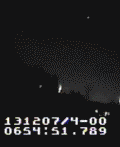  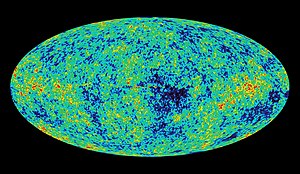
WMAP image of the cosmic microwave background radiation anisotropy. It has the most perfect thermal emission spectrum known
Other Space News
A powerful jet from a supermassive black hole is blasting a nearby galaxy, according to new
data from NASA observatories. This never-before witnessed galactic violence may have a profound effect on planets in the jet's
path and trigger a burst of star birth in its destructive wake.A bright spot in the VLA and MERLIN images shows where the
jet has struck the side of the galaxy, dissipating some of the jet's energy. The collision disrupted and deflected the jet.
A unique aspect of the discovery in 3C321 is how relatively short-lived
this event is on a cosmic time scale. Features seen in the VLA and Chandra images indicate that the jet began impacting the
galaxy about one million years ago, a small fraction of the system's lifetime.
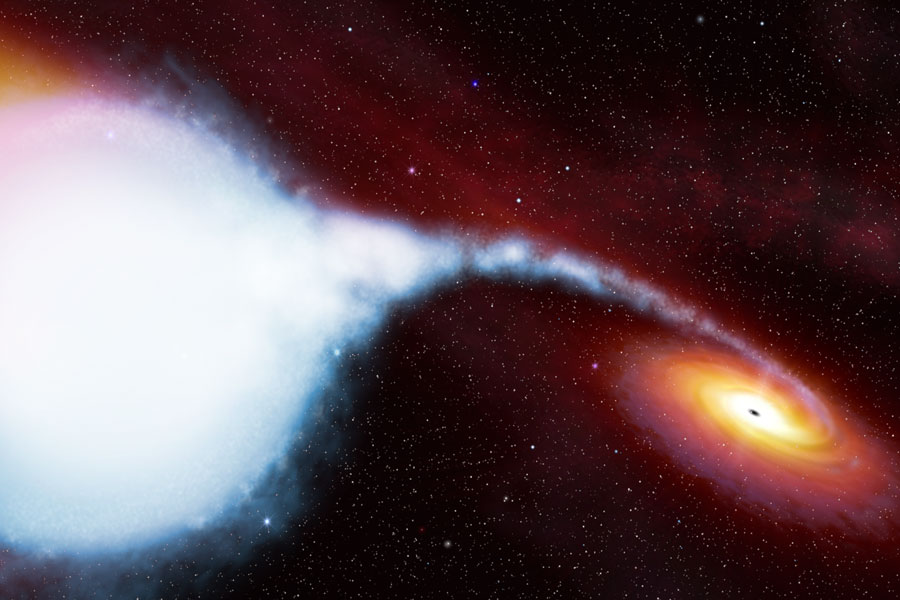 Black Hole Candidate Cygnus X-1 Black Hole Candidate Cygnus X-1 Is that a black hole? Quite possibly. The Cygnus X-1 binary star system contains one of the best candidates for a black hole. The system was discovered because it is one of the brightest X-ray sources on the sky, shining so bright it was detected by the earliest rockets carrying cameras capable of seeing the previously unknown X-ray sky. The star's very name indicates that it is the single brightest X-ray source in the constellation of the Swan Cygnus. Data indicate that a compact object there contains about nine times the mass of the Sun and changes its brightness continually on several time scales, at least
down to milliseconds. Such behavior is expected for a black hole, and difficult to explain with other models. Pictured above is an artistic impression of the Cygnus X-1 system. On the left is the bright blue supergiant star designated HDE 226868, which is estimated as having about 30 times the mass of our Sun. Cygnus X-1 is depicted on the right, connected to its supergiant companion by a stream of gas, and surrounded by an impressive accretion disk. The bright star in the Cygnus X-1 system is visible with a small telescope. Strangely, the Cygnus X-1 black hole candidate appears to have formed without a bright supernova explosion.
NASA funded scientists are now plotting a mission to drill down into the lake and remove a sample of water from the lake for analysis. Lake Vida, buried under Antarctic ice for over 2,500 years, is liquid only because of a high salt content that results from salt being expelled from water above as it turns to ice. Previously, scientists drilled to within
a few meters of the lake and indeed found frozen microbes. Their existence bolsters speculation that similar microorganisms could be found in frozen brine beneath the surface of Mars. If living organisms are found in Lake Vida, they may give an indication that life might even still exist under similar frozen ice-sheets, such as under the larger Lake Vostok, parts of Mars, and even moons of Jupiter such as Europa.  Galileo's Europa
Galileo's Europa
Launched in 1989 and looping through the jovian system since late 1995,
the voyage of NASA's Galileo spacecraft will soon come to an end. The spacecraft has been targeted to plunge directly into Jupiter this Sunday, September 21st, at about 30 miles per second. Its components will be vaporized in the gas giant's outer atmosphere. While
Galileo's long voyage of exploration has resulted in a spectacular scientific legacy, the spacecraft's ultimate fate is related to perhaps its most tantalizing discovery -- strong evidence for a liquid ocean beneath the frozen surface of Jupiter's moon Europa. Galileo is now almost completely out of fuel for maneuvers, so this intentional collision with Jupiter will prevent any
unintentional future collision with Europa and the possibility of contaminating the jovian moon with microbes from Earth hardy enough to survive in interplanetary space. Color image data from the Galileo mission recorded between 1995 and 1998 was used to create this depiction of Europa's cracked and icy surface.
The inset shows dark reddish, disrupted regions dubbed Thera and Thrace
M13: The Great Globular Cluster in Hercules M13 is modestly recognized as the Great Globular Cluster in Hercules. A system of stars numbering in the hundreds of thousands, it is one of the brightest globular star clusters in the northern sky. At a distance of 25,000 light-years, the cluster stars crowd into a region 150 light-years in diameter, but approaching the cluster core over 100 stars would be contained in a cube just 3 light-years on a side. For
comparison, the closest star to the Sun is over 4 light-years away. This stunning view of the cluster combines recent
telescopic images of the cluster's dense core with digitized photographic plates recorded between 1987 and 1991 using the
Samuel Oschin Telescope, a wide-field survey instrument at Palomar Observatory. The resulting composite highlights both
inner and outer reaches of the giant star cluster. Among the distant background galaxies also visible, NGC 6207 is above and to the left of the Great Globular Cluster M13. The Nearest Stars Which stars are closest to the
Sun? The closest is Proxima Centauri, one of three stars that orbit each other about 4 light-years away in the Alpha-Centauri system. Alpha Centauri is easily visible from Earth's Southern Hemisphere. Next is Barnard's Star, a dim star visible with a telescope in the constellation of Ophiuchus. Sirius, the brightest star in the night sky, is part of the fifth closest star system, from which light
takes 8.6 years to reach us. The nearest 25 star systems are shown on the above map, out to 13 light-years. Past that there are probably stars so dim that their proximity has not yet been discovered. Research continues in trying to identify an estimated 130 missing star systems out to 32 light-years.
The closest star system to the Sun is the Alpha Centauri system. Of the three stars in the system, the dimmest -- called Proxima Centauri -- is actually the nearest star. The bright stars Alpha Centauri A and B form a close binary as they are separated by only 23 times the Earth- Sun distance - slightly greater than the distance between Uranus and the Sun. In the above picture, the brightness of the stars overwhelm the photograph causing an illusion of great size, even
though the stars are really just small points of light. The Alpha Centauri system is not visible in much of the northern hemisphere. Alpha Centauri A, also known as Rigil Kentaurus, is the brightest star in the constellation of Centaurus and is the fourth brightest star in the night sky. Sirius is the brightest even thought it is more than twice as far away. By an exciting coincidence,
Alpha Centauri A is the same type of star as our Sun, causing many to speculate that it might contain planets that harbor life.
Proxima Centauri: The Closest Star What is the closest star to our Sun? It is Proxima Centauri, the nearest member of the Alpha Centauri triple star system. Light takes only 4.22 years to reach us from Proxima Centauri. This small red star, captured in the center of the above image, is so faint that it was only discovered in 1915 and is only visible through a telescope. Stars of all types from our Milky Way Galaxy are visible in the background. The brightest star in the Alpha Centauri system is quite similar to our Sun, has been known as long as recorded history, and is the third
brightest star in the night sky. The Alpha Centauri system is primarily visible from Earth's Southern Hemisphere.
It is located about 6.0 light-years away in
the northernmost part (17:57:48.5+04:41:36.2, ICRS 2000.0) of Constellation Ophiuchus, the Serpent Holder -- west of Cebalrai or Kelb al Rai (Beta Ophiuchi). The star was named after its discoverer, noted astronomer Edward Emerson Barnard (1857-1923), who found in 1916 that the star has the largest known proper motion of all known stars (10.3 arcseconds per year). This high apparent speed
is the result of its proximity to Sol as well as actual speed of travel through interstellar space.
In
fact, Barnard's Star is approaching Sol rapidly at 140 kilometers per second (87 miles/second) and will get as close as 3.8
light-years (ly) around 11,800 CE. Like other red dwarfs, however, it is not visible to the naked eye. Due to Barnard's proximity
to Sol, the star has been an object of intense interest among astronomers. It has been selected as a "Tier 1" target star for NASA's optical Space Interferometry Mission (SIM) to detect a planet as small as three Earth-masses within two AUs of its host star (and so some summary system information and images of Barnard's Star are available from the SIM Teams). Astronomers are also hoping to use the ESA's Darwin group of infrared interferometers to analyze the atmospheres of any rocky planet found in the "habitable zone" (HZ) around Barnard's Star for evidence of Earth-type life (Lisa Kaltenegger, 2005).
61 Cygni was christened the "Flying Star" in 1792 by Giuseppe Piazzi (1746-1826) for its unusually large proper motion. This binary system is located about 11.4
light-years (ly) away from our Sun, Sol, in the south central part (21:08:52.1+38:56:51:D~, ICRS 2000.0) of Constellation Cygnus, the Swan -- southeast of Sadr (Gamma Cygni) and east of the open star clusters M 29 and NGC 6871, and the Crescent Nebula (NGC 6888). It is the title member of the 61 Cygni group. yg English
name: Swan (sometimes: Northern Cross) In 1830, Friedrich Georg Wilhelm von Struve (1793-1864) made the first measurements of the star as a binary system. It is now known that 61 Cygni A and B orbit each
other at an "average" distance (semi-major axis) of 86.4 times the Earth-Sun distance, or about 86 astronomical units (AUs)
-- which is more than twice Pluto's orbital distance in the Solar System. 61 Cygni was the first star system (other than the
Sun) to have its distance to Earth successfully calculated by Friedrich Wilhelm Bessel (1784-1846) using trigonometric parallax and the diameter of the Earth's orbit around the Sun in 1838. Smaller and dimmer
than Sol, the stars are barely visible with the naked eye.
Bright, hot, supergiant star Deneb lies at top center in this gorgeous skyscape. The 20 frame mosaic spans an impressive 12 degrees across the northern end of Cygnus the Swan. Crowded with stars and luminous gas clouds along the plane of our Milky Way Galaxy, Cygnus is also home to the dark, obscuring Northern Coal Sack Nebula,
extending from Deneb toward the bottom center of the view. The reddish glow of NGC 7000, the North America Nebula, and IC 5070, the Pelican Nebula, are at the upper left, but many other nebulae and star clusters are identifiable throughout the wide field. Of course, Deneb itself is the alpha star of Cygnus and is also known
to northern hemisphere skygazers for its place in two asterisms -- marking the top of the Northern Cross and a vertex of the Summer Triangle.THREE WHITE STARSBy Jim KalerThree white stars shine out in evening summer twilight, those of the Summer Triangle: Vega (of Lyra), Deneb (of Cygnus), and Altair (of Aquila), stars so familiar, stars of no flashing color, yet stars that have secrets and their own stories
to tell.
High in the sky in early summer evenings is bright white Vega. With a temperature of 9300 Celsius and a luminosity
54 times that of the Sun, Vega -- a mere 25 light years away -- is the second brightest star in the northern hemisphere. Vega
is the astronomer's touchstone. The original magnitude standard was actually Polaris, set to visual mag 2.00. But rescaling and recalibrations brought the standard to Vega, which
now registers magnitude 0.03. With painstaking care, astronomers of the 1960s measured the intensity of the light in its spectrum
against that shining from molten metal, so they could relate the various magnitude scales to energy output in watts. Once
Vega was so calibrated, so were all the other stars. Though there are many standards, there is but one Vega.
In the early
1980s, the Infrared Astronomical Satellite, IRAS, found a cloud of warm dust around the star that suggested some kind of disk
that perhaps might be related to orbiting planets. There is a hole in the disk. Do planets reside there? Have they used the
dust in their making, as did the planets of our Sun? Vega is the paradigm of numerous "Vega-like" stars that include Fomalhaut of the Southern Fish and Denebola in Leo. Vega's reputation as a "standard," however, is a bit compromised by its metal content, which
is only a quarter that of the Sun. Vega also blows out a wind that is seen to extend as much as 1.5 light years from the star.To
the east of Vega lies Deneb, the luminary of Cygnus. Though not as bright as Vega, it is still first magnitude. But it is
also 100 times farther away! Deneb radiates 160,000 times the light of the Sun. At Vega's distance, the star would shine 10,000
times more brightly than it does now, with the light of a crescent Moon. With a mass 20 to 25 times that of the Sun, it is one of the most luminous white stars in the Galaxy, and sometime in the astronomically
near future it will surely explode. If it were go to tonight, it would brighten 10,000 times and again shine like the Moon,
and we would thank our Galaxy for putting it so far from us. If at Vega's distance, the explosion would damage the Earth's
atmosphere and place us all in jeopardy. At 25 light years! Fortunately, no budding supernova is close to us. Even the bright
massive stars of Orion, half Deneb's distance, are too far for any danger.
Then to the south, the southern anchor
of the Summer Triangle, Altair, shines with much less respect. Too bad, because, as one of the faster spinning white stars
of the sky, it is something of a record-holder, rotating so quickly -- over 210 kilometers per second at its equator -- that
it is notably flattened at the poles, this not a theoretician's idea, but actually observed! Contrast that speed to the Sun,
which spins at but 2 kilometers per second and is a near-perfect sphere.
Amazing that we can know the spin rate a star,
of a body that is a near-point in the sky. Finding the rotation of the Sun is easy, as we need look only at the march of spots
across its surface. Cooler stars also have starspots that cause detectable light variations, allowing us to assess the rotation
periods. However, white stars like those of the Summer Triangle do not have spots. Their spins are instead given away by their
spectra. The famed Doppler shift causes waves of all kinds to seem shorter if a body approaches, longer if it recedes. The
characters of stars are known by their spectrum lines, gaps in their colored spectra caused by the absorption of light by
atoms in their outer layers. If a star approaches, the absorptions shift to shorter wavelengths, and vice versa, the shift
easy to measure. Part of a spinning star is coming at you, part going away, hence a spectral absorption is stretched in both
directions, and comes out fuzzy and broad. We can therefore measure the rotation speed, rather a lower limit, since we do
not know how the axis is pitched. Altair's pole has to be close to perpendicular to the line of sight for us to see such mad
turning. Vega, on the other hand seems to spin slowly. Its rotation pole most likely points at us, which is consistent with
the face-on disk around it.
Even more amazing, how do we find Altair's shape? The star is too far away for direct imaging.
Instead we look at the star with a pair of telescopes and observe how the light waves received by each interfere with themselves.
We can thereby mathematically reconstruct the angular diameters. Sophisticated optical "interferometers" can detect angles
as small as a thousandth of a second of arc.
Each of the stars is a guidepost to other stellar wonders. Just to the northeast
of Vega lies little Epsilon Lyrae, the "double-double" in Lyra, a marvelous example of a hierarchical double star, two pairs that
go around each other. The stars of the quartet are nearly identical and were almost certainly born together as the parent
birthcloud split and then each split again. To the southeast lie Beta and Gamma Lyrae, Beta a mass-transferring close binary. Between them sits the easiest-to-find of all planetary
nebulae, the Ring Nebula in Lyra. To the east of Deneb is stellar history, 61 Cygni, an attractive double star that was the first of any star to have its distance measured, and
at a distance of 17 light years is (counting doubles as one) the 13th closest star to Earth. To the northeast is the North America Nebula, which on a dark clear night can -- with difficulty -- be seen with binoculars, if not with
the naked eye. To the south, at the head of Cygnus, is Albireo, the orange and blue wide double (my University's colors!)
Now back to Altair. It sits above a glorious part of the Milky Way, the Scutum star cloud. Just as good, Altair lies just north of Eta Aquilae, which was actually the first-known Cepheid variable. Only by accident do we call this famed class of pulsating stars, those that allow
us to tag the distances of galaxies, "Cepheids" -- they might have been "Aquilids."
Marvelous stars are this trio,
all seeming the same, all very different, all with their own mysteries, as do all the other stars of the heavens. The first magnitude stars of the setting Summer Triangle are all seen in context: Vega of Lyra Deneb of Cygnus
|